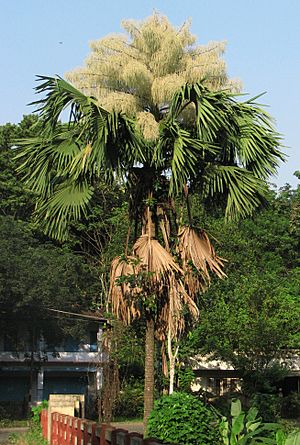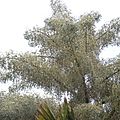Talipot palm facts for kids
Quick facts for kids Talipot palm |
|
|---|---|
 |
|
| Talipot palm flowering at Kerala, India | |
| Conservation status | |
| Scientific classification | |
| Genus: |
Corypha
|
| Species: |
umbraculifera
|
| Synonyms | |
|
|
The talipot palm, also known as Corypha umbraculifera, is a giant palm tree. It originally comes from eastern and southern India and Sri Lanka. You can also find it growing in countries like Cambodia, Myanmar, Thailand, and the Andaman Islands.
Contents
A Giant Among Palms
How Big Can It Grow?
The Talipot palm is one of the biggest palms in the world! Some of these trees can grow as tall as 25 meters (about 82 feet). Their main stem can be as wide as 1.3 meters (over 4 feet).
Its Unique Leaves
This palm is a type of "fan palm." This means its leaves spread out like a giant fan. Each leaf can be up to 5 meters (16 feet) wide. The stem that holds the leaf can be 4 meters (13 feet) long. Each huge leaf can have as many as 130 smaller parts called leaflets.
The Talipot Palm's Amazing Life Cycle
The Biggest Flower Display
The Talipot palm creates the largest flower cluster of any plant on Earth. This amazing display, called an inflorescence, can be 6 to 8 meters (20 to 26 feet) long. It has millions of tiny flowers. These flowers grow on a branched stalk right at the very top of the tree's trunk.
Flowering and Dying
What makes the Talipot palm truly special is how it flowers. It only blooms once in its entire life! This happens when the tree is quite old, usually between 30 and 80 years of age. After it flowers, it takes about a year for its fruit to grow.
The tree produces thousands of round, yellow-green fruits. Each fruit is about 3 to 4 centimeters (1.2 to 1.6 inches) across and holds a single seed. Once the tree has produced its fruit, it dies. This unique life cycle makes the Talipot palm a fascinating plant to learn about.
Images for kids
-
At Lyon Arboretum, Hawaii, U.S.
-
At Jardin Botanique de Deshaies, Guadeloupe
See also
 In Spanish: Palma de Ceilán para niños
In Spanish: Palma de Ceilán para niños








